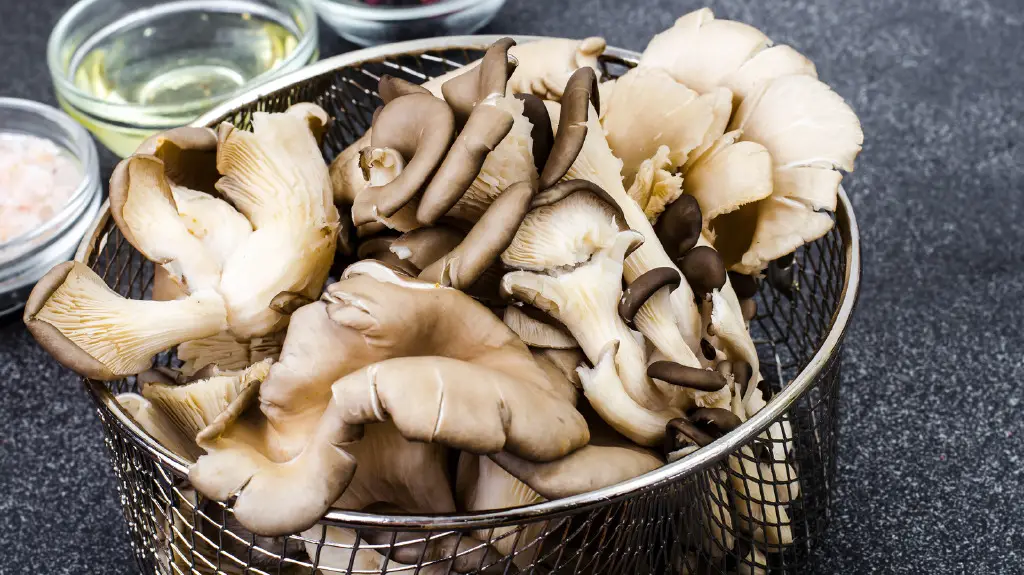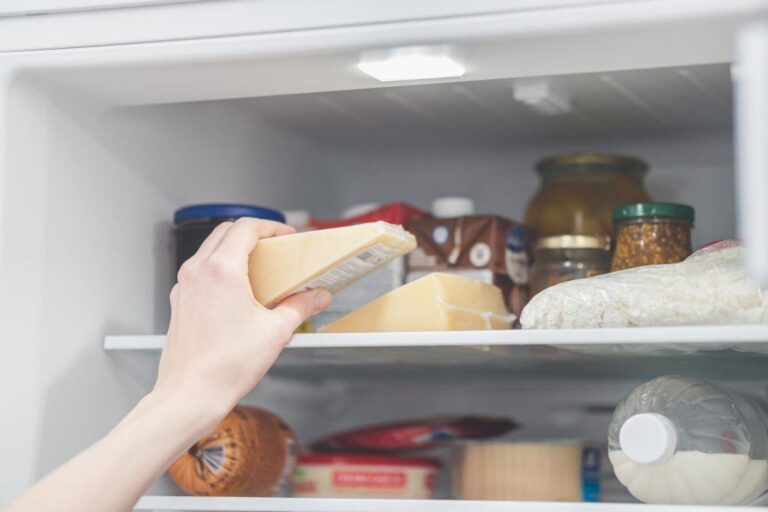Can You Eat Oyster Mushrooms with Mold on Them?

Oyster mushrooms, known for their delicate texture and subtle flavor, are a popular choice in many culinary dishes. However, encountering mold on these delectable fungi can be a cause for concern.
Mold is a common issue that can affect various types of foods, including oyster mushrooms. For a healthy meal, you must understand the risks of eating moldy oyster mushrooms.
In this article, we’ll delve into the intriguing relationship between oyster mushrooms and mold. Can you salvage your fungus delicacy when it’s sporting some unwanted guests, or should you toss them in the compost?
Can you eat oyster mushrooms with mold? Join us on a culinary adventure where science, taste, and adventure collide.
What Do Moldy Oyster Mushrooms Look Like?
Finding mold on oyster mushrooms is an important part of keeping food safe. Mold on oyster mushrooms typically shows up as discolored patches, often appearing as fuzzy or powdery growth.
The color of the mold can vary, ranging from white and grey to green or black, depending on the type of mold present. Oyster mushrooms affected by mold might also emit a musty or unpleasant odor, serving as an extra indicator of spoilage.
The presence of mold can cause the oyster mushrooms to appear slimy or have a wrinkled texture. This appearance signifies advanced stages of spoilage. Before you eat oyster mushrooms that you have bought or picked, you should carefully check them for any signs of mold growth.
Can You Eat Oyster Mushrooms If They Have Mold?
While some molds can indeed be harmful, others are not only safe but also serve as integral components of various culinary delights. Identification of whether the mold is safe or toxic for humans, like below, is important.
Identifying Safe-to-Eat Mold on Oyster Mushrooms
Not all molds are created equal, and some can be quite harmless. Here’s how you can distinguish between safe and unsafe molds on your oyster mushrooms:
| Mold Type | Appearance | Safety |
| White Mold | A fine, powdery substance covers the mushroom. | Generally safe; can be wiped or trimmed off. |
| Brown Spots | Small brown spots or specks on the mushroom. | Typically safe; scrape off affected areas. |
| Black Mold | Black patches or spots on the mushroom’s surface. | Potentially unsafe; best to discard these. |
If you find white mold or brown spots on your oyster mushrooms, they are usually safe to eat. You can simply wipe off the white mold or scrape away the brown spots before using them in your dishes.
However, if you encounter black mold, it’s best to err on the side of caution and discard the affected mushrooms.
Is It Safe to Eat Moldy Oyster Mushrooms If You Cook It?
Cooking moldy oyster mushrooms does not eliminate the potential health risks associated with mold consumption. Heat can destroy some molds and their spores. Certain mycotoxins produced by molds are heat-resistant and can withstand cooking temperatures. So, cooking moldy oyster mushrooms does not always get rid of all the harmful chemicals, so they are still not safe to eat.
Oyster mushrooms may lose their texture and flavor when cooked, making it hard to distinguish their flavors from mold mustiness. To prioritize food safety, you better discard any oyster mushrooms with visible mold growth, even if they are intended for cooking.
Health Concerns with Moldy Oyster Mushrooms
Proper cleaning and preparation can remove safe molds on oyster mushrooms, but moldy fungi can be harmful.
Mold produces mycotoxins, which are toxic compounds that can be harmful to humans when consumed in large quantities. Inhaling mold spores can also lead to respiratory problems. As such, if your oyster mushrooms are heavily covered in mold or the mold has penetrated deep into the mushroom, just discard them to avoid health risks.
How Can Mold Get into Oyster Mushrooms?

Environmental conditions that promote fungal growth can cause oyster mushroom mold infestation. Factors such as high humidity levels, improper storage, and inadequate air circulation can create favorable conditions for mold spores to thrive and grow on mushroom surfaces.
Lack of hygiene and sanitation during cultivation and harvesting can also cause contamination. Failure to maintain clean harvesting equipment, storage containers, and processing facilities can facilitate the transfer of mold spores onto the oyster mushrooms, leading to rapid spoilage and compromised quality.
Employing stringent quality control measures, including regular inspections, proper ventilation, and hygienic handling practices, can significantly reduce the risk of mold contamination in oyster mushrooms, ensuring their freshness and safety for consumption.
How Long Are Oyster Mushrooms Good For? (Oyster Mushrooms Shelf Life)
When stored in optimal conditions, oyster mushrooms can retain their quality for up to one week in the refrigerator. The shelf life of oyster mushrooms depends on their variety and cultivation environment.
To extend their shelf life, store them in a paper bag or a breathable container in the refrigerator. This will provide adequate air circulation to prevent moisture buildup and mold formation.
Read: How to Check Slimy Mushroom Is Fresh or Not?
How to Prevent Oyster Mushrooms From Molding?
Preventive measures are needed to minimize the risk of mold formation and extend the shelf life of oyster mushrooms. Several methods can prevent mold growth, keeping mushrooms fresh and edible.
- Proper Storage: Store oyster mushrooms in a cool, dry place, ideally in the refrigerator, to inhibit the growth of mold and preserve their texture and flavor.
- Adequate Ventilation: Use breathable containers or paper bags to facilitate air circulation, preventing excess moisture accumulation that can encourage mold growth.
- Regular Inspection: Routinely examine the oyster mushrooms for any signs of discoloration, sliminess, or unusual odors, promptly discarding any specimens exhibiting these characteristics.
- Hygienic Handling: Maintain proper hygiene during the handling and preparation of oyster mushrooms, ensuring that all utensils and surfaces remain clean and sanitized to prevent cross-contamination.
By following these precautions, oyster mushrooms can be kept fresh and mold-free for longer.
Does Oyster Mushrooms Go Bad If Not Refrigerated?
Oyster mushrooms can be kept fresh for a short time without refrigeration, but refrigeration is recommended.
Oyster mushrooms stored in a cool, well-ventilated area away from direct sunlight can remain viable for a day or two. However, prolonged exposure to room temperature can accelerate the deterioration process, leading to rapid spoilage and mold formation.
Extreme heat and humidity can accelerate mold spore growth on oyster mushrooms, making them unfit for consumption. Therefore, just refrigerate oyster mushrooms promptly after purchase or harvest to maintain their texture, flavor, and nutritional value for an extended period.
How Can You Tell If an Oyster Mushroom Has Gone Bad?
Identifying the signs of spoilage is vital in determining the edibility of oyster mushrooms. Several visual and olfactory cues can indicate that oyster mushrooms have gone bad and should be discarded to prevent any adverse health effects.
- Discoloration: Noticeable changes in color, such as darkening or the presence of unusual hues, can signify spoilage and the onset of mold growth.
- Sliminess: A slimy or sticky texture is a clear indication of bacterial or fungal contamination, rendering the oyster mushrooms unfit for consumption.
- Unpleasant Odor: Foul or musty odors emanating from the oyster mushrooms suggest the presence of mold or bacterial activity, warranting their immediate disposal.
- Wrinkled Appearance: Oyster mushrooms that appear shriveled, dried out, or have a wilted appearance indicate loss of moisture and compromised freshness.
If any of these indicators are observed, just discard the oyster mushrooms to prevent the risk of foodborne illnesses and ensure a safe culinary experience.
Conclusion
In conclusion, while oyster mushrooms are a delightful addition to various culinary creations, it is crucial to exercise caution when dealing with mold-contaminated specimens.
Understanding the signs of mold growth, staying away from oyster mushrooms that are moldy, knowing that cooking can not completely get rid of mold, and taking steps to avoid contamination are all important for keeping this tasty fungus safe and intact.
By prioritizing food safety practices, individuals can savor the exquisite flavors of oyster mushrooms without compromising their well-being.
FAQs on Health Risks of Eating Moldy Oyster Mushrooms
What happens if you eat mushrooms with mold?
Eating mushrooms with mold can lead to adverse health effects, including allergic reactions, respiratory issues, and gastrointestinal discomfort. Certain molds produce mycotoxins that can be particularly dangerous when ingested.
How can you identify mold on oyster mushrooms?
Mold on oyster mushrooms appears as discolored patches, often fuzzy or powdery in texture. It can be white, grey, green, or black. Moldy oyster mushrooms might also emit a musty odor, indicating spoilage.
How long do oyster mushrooms last in the refrigerator?
Oyster mushrooms can last up to a week in the refrigerator if stored properly in a paper bag or a breathable container with adequate air circulation.
Can you freeze oyster mushrooms to extend their shelf life?
Freezing can alter the texture of oyster mushrooms, resulting in a mushy consistency when thawed. It is generally recommended to consume oyster mushrooms fresh for the best culinary experience.
What is the best way to store oyster mushrooms to prevent mold growth?
Store oyster mushrooms in a cool, dry place or in the refrigerator. Use breathable containers to promote air circulation and prevent moisture buildup, which can lead to mold formation.
Are there any safe ways to remove mold from oyster mushrooms?
It is not recommended to remove mold from oyster mushrooms as some mycotoxins can permeate the entire mushroom. It is safer to discard any mushrooms with visible mold to avoid potential health risks.






